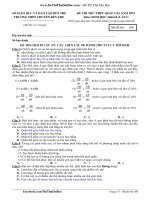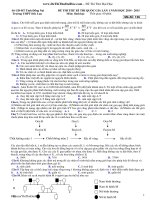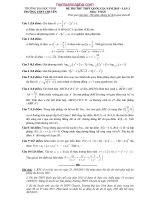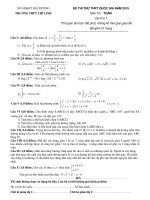De thi thu THPT QG
Bạn đang xem bản rút gọn của tài liệu. Xem và tải ngay bản đầy đủ của tài liệu tại đây (131.32 KB, 6 trang )
<span class='text_page_counter'>(1)</span>SỞ GD&ĐT THANH HÓA TRƯỜNG THPT NÔNG CỐNG I ĐỀ CHÍNH THỨC. ĐỀ THI KHẢO SÁT CHẤT LƯỢNG LẦN 2 NĂM HỌC 2015-2016 MÔN THI: TIẾNG ANH 12 Thời gian: 90 phút, không kể thời gian giao đề. SECTION A: (8 points) Mã đề thi Read the following passage and mark the letter A, B, C, or D on your answer sheet to indicate theA121 correct answer to each of the questions. After inventing dynamite, Swedish-born Alfred Nobel became a very rich man. However, he foresaw its universally destructive powers too late. Nobel preferred not to be remembered as the inventor of dynamite, so in 1895, just two weeks before his death·, he created a fund to be used for awarding prizes to people who had made worthwhile contributions to humanity. Originally there were five awards: literature, physics, chemistry, medicine, and peace. Economics was added in 1968, just sixty-seven years after the first awards ceremony. Nobel's original legacy of nine million dollars was invested, and the interest on this sum is used for the awards which vary from $30,000 to $125,000. Every year on December 10, the anniversary of Nobel's death, the awards (gold medal, illuminated diploma, and money) are presented to the winners. Sometimes politics plays an important role in the judges' decisions. Americans have won numerous science awards, but relatively few literature prizes. No awards were presented from 1940 to 1942 at the beginning of World War II. Some people have won two prizes, but this is rare; others have shared their prizes. Câu 1: The word "legacy" in the second paragraph means most nearly the same as _______. A bequest B prize C debt D legend Câu 2: In how many fields are prizes bestowed? A 6 B 5 C 2 D 10 Câu 3: All of the following statements are true EXCEPT A ceremonies are held on December 10 to commemorate Nobel's invention B Politics plays an important role in selecting the winners C A few individuals have won two awards D Awards vary in monetary value Câu 4: How much money did Nobel leaves for the prizes? A $9,000,000 B $155,000 C $125,000 D $30,000 Câu 5: The Nobel prize was established in order to _________. A recognize worthwhile contributions to humanity B spend money C resolve political differences D honor the inventor of dynamite Câu 6: In the first paragraph, "worthwhile" is closest in meaning to _________ . A valuable B trivial C economic D prestigious Câu 7: The word "foresaw" in the first paragraph is nearest in meaning to ________. A postponed B predicted C prevailed D prevented Câu 8: According to the passage, Nobel's profession was in _________ . A literature B economics C medicine D science Câu 9: What is the main idea of this passage? A Alfred Nobel created awards in six categories for contributions to humanity. B Alfred Nobel left all of his money to science. C Alfred Nobel became very rich when he invented dynamite D Alfred Nobel made a lasting contribution to humanity Câu 10: In which area have Americans received the least awards? A Economics B Science C Peace D Literature Choose the option A, B, C or D to indicate which of the following words has the bold, italic part pronounced differently from others. Câu 11: A killed B crashed C waved D cured Câu 12: A stays B tells C talks D steals.
<span class='text_page_counter'>(2)</span> Câu 13: A church. B machine. C changeable. D cheese. Mark the letter A, B, C, or D on your answer sheet to indicate the word whose stress is placed differently from that of the others in each of the following questions. Câu 14: A primary B employee C difference D recognize Câu 15: A predict B patient C police D attract Mark the letter A, b, C, or D to identify the underlined part that is not correct. Câu 16: Looking from afar, the village resembles a small green spot dotted with tiny fireballs. A Resembles B with C green spot D Looking Câu 17: The more frequently you exercise, the greatest physical endurance you will have. A greatest B frequently C will have D exercise Câu 18: The doctor advised him to avoid eating fatty foods, having more vegetables and drink much water. A eating B having C much D advised him Câu 19: The number of homeless people in Nepal have increased sharply due to that severe earthquake. A Have B Of C due to D severe earthquake Câu 20: Since poaching is becoming more seriously, the government has imposed stricter laws to prevent it. A Poaching B Seriously C Stricter D it Mark the letter A, B, C, or D on your answer sheet to indicate the word(s) OPPOSITE in meaning to the underlined word(s) in each of the following questions. Câu 21: Schooling is compulsory for all Vietnamese children from the age of 6 to 14. A obeyed B required C obligatory D optional Câu 22: An optimistic person always sees things on the bright sides. A intelligent B pesimistic C comfortable D difficult Mark the letter A, B, C, or D on your answer sheet to indicate the correct answer to each of the following questions. Câu 23: - Anne: " Make yourself at home". - John: "_______" A Thanks! Same to you. B Not at all. Don't mention it. C Yes, Can I help you? D That's very kind. Thank you. Câu 24: Books and magazines ______ around made his room very untidy. A that lie B laying C which lied D lying Câu 25: He agreed to sign the contract _______. A so he didn’t know much about that company B in spite he knew much about that company C although he didn’t know much about that company. D because he didn’t know much about that company’s director. Câu 26: I can _____ with most things but I cannot stand noisy children. A put aside B put on C put off D put up Câu 27: The passengers had to wait because the plane ______ off an hour late. A cut B turned C took D made Câu 28: No sooner _____ at the bus stop ______ the bus came. A he had arrived/ when B he had arrived/ than C had he arrived/ than D had he arrived/ when Câu 29: ______ arrived earlier, we could have finished the task. A Had we B If we hadn’t C Unless we had D If we have Câu 30: The manager had his brother ______ the report for him. A to typed B typing C type D typed Câu 31: My uncle ______ a very beautiful house in town last year. A buy B bought C will buy D is building Câu 32: You can _____ the meaning of the new words in the dictionary. A look after B look at C look up D look for Câu 33: I said that I had met her ______. A yesterday B the day C the before day. D the previous day.
<span class='text_page_counter'>(3)</span> Câu 34: A Câu 35: A Câu 36: A Câu 37: A C Câu 38: A Câu 39: A Câu 40: A Câu 41: A. If I _____ you, I would give Mary a lift. would be B am C had been D were There were two small rooms in the beach house, _____ served as a kitchen. the smaller of which B the smaller of them C the smallest of which D smallest of that After having used the new technique, the factory produced ____ cars in 2014 as the year before. as twice many B as many twice C twice many as D twice as many John asked me ______ interested in. what kind of sports I was B what kind of sports was I what kind of sports I am D what kind of sports am I They are very happy because a new school for their children _____ in their village now. has been built B is being built C is building D has build ______ from outer space, our earth looks like a “blue planet” Be seen B Seeing C Seen D Having seen The girls and flowers __________ he painted were vivid. that B who C which D whose __________he missed the first bus, he came ten minutes late. Although B Because C However D Therefore. Mark the letter A, B, C, or D on your answer sheet to indicate the word(s) CLOSEST in meaning to the underlined word(s) in each of the following questions. Câu 42: Magma is the primary source of all the earth’s rocks. A cheapest B nearest C worst D first Câu 43: The organization was established in 1950 in the USA. A come around B made out C put on D set up Câu 44: The ASEAN Para-Games are hosted by the same country where the SEA Games took place. A defended B impressed C participated D organized Read the following passage and mark the letter A, B, C, or D on your answer sheet to indicate the correct answer to each of the questions. An air pollutant is defined as a compound added directly or indirectly by humans to the atmosphere in such quantities as to affect humans, animals, vegetation, or materials adversely. Air pollution requires a very flexible definition that permits continuous change. When the first air pollution laws were established in England in the fourteenth century, air pollutants were limited to compounds that could be seen or smelled - a far cry from the extensive list of harmful substances known today. As technology has developed and knowledge of the health aspects of various chemicals has increased, the list of air pollutants has lengthened. In the future, even water vapor might be considered an air pollutant under certain conditions. Many of the more important air pollutants, such as sulfur oxides, carbon monoxide, and nitrogen oxides, are found in nature. As the Earth developed, the concentration of these pollutants was altered by various chemical reactions; they became components in biogeochemical cycles. These serve as an air purification scheme by allowing the compounds to move from the air to the water or soil. On a global basis, nature's output of these compounds dwarfs that resulting from human activities. However, human production usually occurs in a localized area, such as a city. In such a region, human output may be dominant and may temporarily overload the natural purification scheme of the cycles. The result is an increased concentration of noxious chemicals in the air. The concentrations at which the adverse effects appear will be greater than the concentrations that the pollutants would have in the absence of human activities. The actual concentration need not be large for a substance to be a pollutant; in fact, the numerical value tells us little until we know how much of an increase this represents over the concentration that would occur naturally in the area. For example, sulfur dioxide has detectable health effects at 0.08 parts per million (ppm), which is about 400 times its natural level. Carbon monoxide, however, has a natural level of 0.1 ppm and is not usually a pollutant until its level reaches about 15 ppm. Câu 45: It can be inferred from the first paragraph that _________. A water vapor is an air pollutant in localized areas B the definition of air pollution will continue to change C most air pollutants today can be seen or smelled D a substance becomes an air pollutant only in cities Câu 46: Which of the following is best supported by the passage?.
<span class='text_page_counter'>(4)</span> A One of the most important steps in preserving natural lands is to better enforce air pollution laws. B Scientists should be consulted in order to establish uniform limits for all air pollutants. C Human activities have been effective in reducing air pollution. D To effectively control pollution, local government should regularly review their air pollution laws. Câu 47: The word "detectable" in the third paragraph is closest in meaning to _________ . A measurable B beneficial C special D separable Câu 48: The word "These" in the second paragraph is closest in meaning to _________. A the pollutants from the developing Earth B the components in biogeochemical cycles C the compounds moved to the water or soil D the various chemical reactions Câu 49: According to the passage, the numerical value of the concentration level of a substance is only useful if _______. A it is in a localized area B the other substances in the area are known C it can be calculated quickly D the natural level is also known Câu 50: The word "localized" in the third paragraph is closest in meaning to _________. A specified B surrounded C encircled D circled. Câu 51: According to the passage, human-generated air pollution in localized regions _______. A will damage areas outside of the localized regions B will react harmfully with natural pollutants C can overwhelm the natural system that removes pollutants D can be dwarfed by nature's output of pollutants Câu 52: What does the passage mainly discuss? A The economic impact of air pollution. B The effects of compounds added to the atmosphere. C How much harm air pollutants can cause. D What constitutes an air pollutant. Câu 53: For which of the following reasons can natural pollutants play an important role in controlling air pollution? A They occur in greater quantities than other pollutants. B They function as part of a purification process. C They are less harmful to living beings than other pollutants. D They have existed since the Earth developed. Câu 54: The word "adversely" in the first paragraph is closest in meaning to _________ . A negatively B admittedly C considerably D quickly Read the following passage and mark the letter A, B, C or D on your answer sheet to indicate the correct answer to each of the following questions. Speech is one of the most important (55) _________ of communicating. It consists of far more than just making noises. To talk and also to (56) _________ by other people, we have to speak a language, that is, we have to use combinations of (57)_________ that everyone agrees to stand for a particular object or idea. Communication would be impossible if everyone made up their own language. Learning a language properly is very (58)_________ . The basic (59) _________ of English is not very large, and not only about 2,000 words are needed to speak it quite (60) _________. But the more idea you can (61) _________ the more precise you can be about their exact meaning. Words are the (62)_________ thing we use in communicating what we want to say. The way we (63) _________ the words is also very important. Our tone of voice can express many emotions and (64) _________ whether we are pleased or angry, for instance. Câu 55: A rules B reason C ways D tests Câu 56: A be spoken B be examined C be understood D be talked Câu 57: A systems B talks C sounds D languages Câu 58: A simple B important C expensive D easy Câu 59: A vocabulary B grammar C structure D word Câu 60: A fluent B perfect C well D good Câu 61: A pass B express C grow D need Câu 62: A most B certain C main D full Câu 63: A send B talk C say D pass Câu 64: A understand B ask C show D know.
<span class='text_page_counter'>(5)</span> SECTION B: (2 points) A. Rewrite the following sentences in such a way that they mean almost the same as those printed before them. Question 1: No one has used that door for 20 years. à That door ____________________________________________. Question 2: “I am sorry I did not phone you earlier,” said John. à John apologized ________________________________________. Question 3: It was not nice of you not to invite me to your party. à I might _______________________________________________. Question 4: This is the first time I have ever tasted such a delicious meal. à I have ________________________________________________. Question 5: If he does not obey the rules, he will be sacked soon. à Unless ________________________________________________. B. In about 140 words, write a paragraph to describe the ideal world where you would like to live in the future. Your writing might consist of following prompts: - The world of peace. - The world of no pollution - The world of no unemployment. --------- THE END -------Thí sinh không được sử dụng tài liệu. Cán bộ coi thi không giải thích gì thêm..
<span class='text_page_counter'>(6)</span> ĐÁP ÁN SECTION A: (8 points) Đáp án mã đề thi A121 1. A 2. A 3. A 4. A 5. A 8. D 9. D 10. D 11. B 12. C 15. B 16. D 17. A 18. B 19. A 22. B 23. D 24. D 25. C 26. D 29. A 30. C 31. B 32. C 33. D 36. D 37. A 38. B 39. C 40. A 43. D 44. D 45. B 46. C 47. A 50. A 51. C 52. D 53. B 54. A 57. C 58. B 59. A 60. C 61. B 64. C SECTION B: (2 points) Question 1: That door has not been used for 20 years. Question 2: John apologized for not phoning/ having phoned me earlier. Question 3: I might have been invited to your party. Question 4: I have never/ not tasted such a delicious meal before. Question 5: Unless he obeys the rules, he will be sacked soon.. 6. A 13. B 20. B 27. C 34. D 41. B 48. B 55. C 62. C. 7. B 14. B 21. D 28. C 35. A 42. D 49. D 56. C 63. C.
<span class='text_page_counter'>(7)</span>









